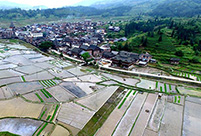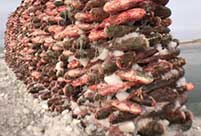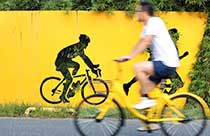

 |
Between April 15 and 28, a delegation of 15 people from a French College of Traditional Chinese Medicine have a two-week clinical study of traditional Chinese medicine (TCM) at the First Hospital of Hunan University of Chinese Medicine. They were arranged to learn pediatric Tui na, dermatology knowledge and other TCM techniques here. After the training, they would bring back what they have learnt to France and treat their patients with traditional Chinese medicine skills.
Tui na (Chinese: 推拿) is a form of Chinese manipulative therapy often used in conjunction with acupuncture, moxibustion, fire cupping, Chinese herbalism, t'ai chi, and qigong Tui na is a hands-on body treatment that uses Chinese taoist principles in an effort to bring the eight principles of Traditional Chinese Medicine (TCM) into balance. The practitioner may brush, knead, roll, press, and rub the areas between each of the joints, known as the eight gates, to attempt to open the body's defensive chi (Wei Qi) and get the energy moving in the meridians and the muscles. Techniques may be gentle or quite firm. The name comes from two of the actions: tui means "to push" and na means "to lift and squeeze." Other strokes include shaking and tapotement. The practitioner can then use range of motion, traction, with the stimulation of acupressure points. These techniques are claimed to aid in the treatment of both acute and chronic musculoskeletal conditions, as well as many non-musculoskeletal conditions. As with many other traditional Chinese medical practices, there are different schools which vary in their approach to the discipline. It is related also to Japanese massage or anma.
In ancient China, medical therapy was often classified as either "external" or "internal" treatment. Tui na was one of the external methods, thought to be especially suitable for use on the elderly population and on infants. In modern China, many hospitals include tui na as a standard aspect of treatment, with specialization for infants, adults, orthopedics, traumatology, cosmetology, rehabilitation, and sports medicine. In the West, Tui na is taught as a part of the curriculum at some acupuncture schools.
Source: www.enghunan.gov.cn
 |  |
 Spring scenery of paddy field in central, south China
Spring scenery of paddy field in central, south China Enjoy the annual celebration of martial arts and music
Enjoy the annual celebration of martial arts and music Fishermen build wall with 2,000 fish in Jilin
Fishermen build wall with 2,000 fish in Jilin In pics: Longzhou Danxia landform in NW China
In pics: Longzhou Danxia landform in NW China China's "four great new inventions" in modern times
China's "four great new inventions" in modern times Chinese brand becomes largest handset provider in Africa
Chinese brand becomes largest handset provider in Africa Busty Lais Ribeiro steals the Victoria's Secret Fashion Show
Busty Lais Ribeiro steals the Victoria's Secret Fashion Show Highlights Victoria's Secret Fashion Show in Shanghai
Highlights Victoria's Secret Fashion Show in Shanghai China's first cross-sea rail-road bridge takes shape
China's first cross-sea rail-road bridge takes shape Top 10 most sustainable cities in China
Top 10 most sustainable cities in China Top 10 European patent applicants in 2016
Top 10 European patent applicants in 2016 The power of 'She' in China
The power of 'She' in China Seven most beautiful art museums in China
Seven most beautiful art museums in China Upcoming trade negotiations a tough job
Upcoming trade negotiations a tough job
 Some Chinese HIV/AIDS patients give up free medication to buy drugs from overseas
Some Chinese HIV/AIDS patients give up free medication to buy drugs from overseas
 Kungfu master fights to continue traditional martial art
Kungfu master fights to continue traditional martial art
 Boost for Made in China 2025
Boost for Made in China 2025
Day|Week